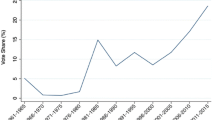Abstract
GDP was $738 per capita in Brazil and $807 in the United States in 1800, but was $4,854 in the latter in 1900 and actually fell from $738 inBrazil by 1913. Relative factor endowments and institutions, broadlyconsidered, are twin traditional explanations for the extremely diversegrowth rates. In this paper we offer a complementary analysis of specificpolitical and economic structures to help explain the success andpersistence of monopoly restrictions in Brazil and the failure of internalmercantilism in the U.S. We conclude that Brazilian institutions provideda ripe and efficient environment for rent seeking. Such conditions did notexist in the U.S., a fact that helped produce the vast difference ingrowth in the 1800s.
Similar content being viewed by others
References
Bailyn, B. (1965). The origins of American politics. New York: Vintage Books.
Caldeira, J. (1995). Mauá: Um Empresário do Império. Rio de Janeiro: Companhia das Letras.
Carvalho, J.M. (1980). Elite and state-building in imperial Brazil. Ph.D. dissertation, University of Michigan.
Carvalho, J.M. (1980). A construção da ordem: A elite politica imperial. Rio de Janeiro: EditoraCampus.
Coatsworth, J. (1993). Notes on the comparative economic history of Latin America and the United States. In Bernecker, W. and Tobler, H.W. (Eds.), Development and underdevelopment in America, vol. 8. De Gruyter Studies on North America.
Coatsworth, J. and Taylor, A. (Eds). (1998). Latin America and the world economy since 1800. Harvard University: The David Rockefeller Center Series on Latin American Studies.
Costa, E.V. da. (1985). The Brazilian empire. Chicago and London: University of Chicago Press.
Demsetz, H. (1998). Dogs and tails in the economic development story. Second Annual Conference of the International Society for the New Institutional Economics, Paris. http://www.isnie.org/ISNIE98/demsetz98.doc.
DeRoover, R. (1948). The Medici Bank. New York: New York University Press.
Ekelund, R.B. and Tollison, R.D. (1981). Mercantilism as a rent-seeking society: Economic regulation in historical perspective. College Station: Texas A&M University Press.
Ekelund, R.B. and Tollison, R.D. (1997). Politicized economies: Monarchy, monopoly, and mercantilism. College Station, TX: Texas A&M University Press.
Engerman, S. and Sokoloff, K. (1997). Factor endowments, institutions, and differential paths of growth among new world economies: A view from economic historians of the United States. In Haber, S. (Ed.), How Latin America fell behind: Essays of the economic histories of Brazil and Mexico, 1800–1914. Stanford University Press.
Engerman, S. and Sokoloff, K. (2000). History lessons: Institutions, factor endowments, and paths of development in the new world. Journal of Economic Perspectives 14: 217–232.
Ewbank, T. (1856). Life in Brazil or a journal of a visit to the land of the cocoa and the palm. Detroit, MI: Blaine Ethridge Books.
Faoro, R. (1997). Os donos do poder. São Paulo: Editora Globo.
Faith, R. and Tollison, R.D. (1983). Voter search for efficient representation. Research in Law and Economics 5: 211–224.
Ludwig, A. (1985). Brazil: A handbook of historical statistics. Boston, MA: G.K. Hall.
Maddison, A. (1994). Explaining the economic performance of nations, 1820–1989. In: Baumol, W., Nelson, R. and Wolff, E. (Eds.), Convergence of productivity: Cross-national studies and historical evidence. Oxford: Oxford University Press.
Maddison, A. (1995). Monitoring the world economy 1820–1992. Paris: OECD.
Marchant, A. (1965). Viscount Mauá and the empire of Brazil. Berkeley and Los Angeles: University of California Press.
Moog, V. (1964). Bandeirantes and pioneers. New York: G. Brazillier.
North, D. (1989). Institutions and economic growth: An historical introduction. World Development 17: 1319–1332.
North, D. (1990). Institutions, institutional change and economic performance. Cambridge: Cambridge University Press.
North, D., Summerhill, W. and Weingast, B.R. (2000). Order, disorder and economicchange: Latin America vs. North America. In Bueno de Mesquita, B. and Root, H. (Eds.), Governing for prosperity. New Haven: Yale University Press. http://www.stanford.edu/group/polisci/Faculty/weingast_pub.html.
Pang, E.-S. and Seckinger, R. The mandarins of imperial Brazil. Comparative Studies in Society and History 9: 213–244.
Perkins, D. and Van Deusen, G.G. (1963). The United States of America: A history. Vol 1.New York: The MacMillan Company.
Schaeper, T.J. (1983). The French Council of Commerce, 1700–1715: A study of mercantilism after Colbert. Columbus: Ohio State University Press.
Tavares-Bastos, A.C. ([1861] 1976). Os males do presente e as esperanças do futuro. São Paulo: Companhia Editoria Nacional/INL.
Tavares-Bastos, A.C. ([1866] 1975). O vale de Amazonas. São Paulo: Companhia Editoria Nacional/INL.
Tavares-Bastos, A.C. ([1870](1976)). A. provincia. São Paulo: Companhia Editora Nacional/INL.
Thompson, I.A. (1979). The purchase of nobility in Castile, 1552–1700. Journal of European Economic History 8: 313–360.
Tullock, G. (1974). The social dilemma. Blacksburg, VA: Center for Study of Public Choice.
Weingast, B.R. (1995). The economic role of political institutions: Market-preserving federalism and economic development. Journal of Law, Economics and Organization 11: 1–31.
Wells, J. and Wills, D. (2000). Revolution, restoration, and debt repudiation: The Jacobite threat to England's institutions and economic growth. The Journal of Economic History 60: 418–441.
Author information
Authors and Affiliations
Rights and permissions
About this article
Cite this article
Zanella, F.C., Ekelund, R.B. & Laband, D.N. Monarchy, Monopoly and Mercantilism: Brazil Versus the United States in the 1800s. Public Choice 116, 381–398 (2003). https://doi.org/10.1023/A:1024807728596
Issue Date:
DOI: https://doi.org/10.1023/A:1024807728596



